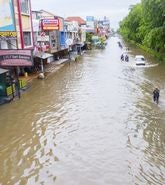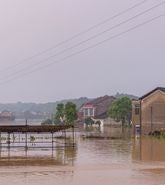In March this year, I joined a team of six RMS employees and three clients travelling to Manila in the Philippines on the annual RMS Impact Trek, as part of an ongoing partnership with Build Change. RMS and Build Change share the aim of increasing resiliency and reducing the impact of disasters, especially in the communities that are most vulnerable to their effects. The Philippines is one of the most disaster-prone countries in the world; its position on both the Pacific Ring of Fire and within the western North Pacific tropical cyclone basin means the country is at risk from both earthquakes and typhoons.
Previous Impact Treks had taken participants to Haiti and Nepal – countries which were at the time recovering from the impacts of catastrophic earthquakes. This year was different, in that Manila has not experienced a recent disaster, and the Trek focused on pre-disaster measures that can be taken to increase resiliency and prepare for the next big event when it inevitably occurs.
Similarities Between Manila and Haiti
At 4.53 p.m. local time on Tuesday, January 12, 2010, the city of Port-Au-Prince, the capital of Haiti in the Caribbean, was struck by a devastating magnitude Mw7.0 earthquake. In a country where the death toll from earthquakes in the preceding century totalled just ten, an estimated 160,000 people lost their lives in that one afternoon. Government figures suggest that 250,000 homes and 30,000 commercial buildings collapsed or suffered severe damage, and other infrastructure across the city was also destroyed. The total economic cost of the disaster was estimated at the time to be between US$7.8 and US$8.5 billion, which could rise to US$13.9 billion over time.
Kate Landry, the Philippines Country Director for Build Change, has been working in the country for five years and had previously worked in Haiti, both before and after the 2010 earthquake. During our visit to the Philippines, she commented on the many similarities between the community of Pembo, Manila, and the communities of Port-au-Prince in Haiti which had been worst affected by the 2010 earthquake. Pembo (pop. ~44,000) is one of the poorest communities in Manila, and the stark contrast between this area and the nearby Bonifacio Global City (BGC), which has undergone massive urban redevelopment, is strikingly evident.
My first impressions upon entering Pembo were one of a busy and vibrant community, with numerous little shops and market stalls lining the narrow winding streets as taxi-trikes buzz past in all directions. The buildings here seem to be constructed in a somewhat disorderly fashion, but it is on closer inspection that the true vulnerability of this community becomes apparent. Many residences here have incomplete structural columns or are missing them altogether. Walls constructed from heavy masonry blocks are not properly cemented together or confined by horizontal beams. There are often no connections between homes and their foundations. Openings such as windows and doors are large and irregularly spaced, reducing the structural stability of the walls. In the event of even a mid-strength earthquake, this community would likely suffer heavy damage.
The residents of Pembo are well aware of the threat of earthquakes where they live. A study by the Philippine Institute of Volcanology and Seismology (PHIVOLCS) of potential earthquake damage identified a magnitude Mw7.2 earthquake on the West Valley Fault as the worst-case scenario – dubbed “The Big One”. Four major earthquakes have occurred on this fault in the last 1,400 years, with a recurrence interval of around 400 years. The last major earthquake occurred 361 years ago, so there is a belief the next one may happen soon. The concern, given the similarities in substandard buildings in parts of Manila and the similar tectonic setting to Port-au-Prince, is that an earthquake of this magnitude on the West Valley Fault could cause casualty and damage statistics similar to the 2010 Haiti earthquake.

View over Pembo district
Increasing Resiliency in Pembo
Part of the 100 kilometer West Valley Fault runs directly through the community of Pembo, with one resident pointing out that the local hospital is constructed right on top of the fault line. Many people here are living in houses built by their parents or grandparents, on land given to them by the government many years ago. The historic and family connections they have to the area are strong and they are keen to stay, despite the high earthquake risk. Nevertheless, there is a desire among the community to reduce that risk and to ensure their families are safe and their homes resilient when “The Big One” occurs.
Build Change are helping to make this happen in Pembo, and in communities like it throughout the Philippines. The mission of Build Change is to reduce deaths, injuries, and economic losses caused by earthquakes and typhoons. In Pembo, Build Change is raising awareness on the effects of disasters to stimulate demand for retrofitting, and provide guidance to local engineers and builders in how to retrofit existing buildings and construct safer homes. They work with local microfinance partners to develop affordable loan schemes that enable the residents of vulnerable communities to retrofit their homes, which they would otherwise not be able to pay for.
Evidence of the difference that Build Change is making in Pembo is already apparent. Several homes here have been retrofitted to reduce the risk of building collapse during the next earthquake. Columns have been added or strengthened, masonry walls have been plastered and confined with crossbeams, foundations have been connected, door frames added, and windows reduced in size to increase the solid wall area. Such retrofitting measures are designed to a standard that should see these homes withstand a magnitude Mw8.0 earthquake. Residents of the homes that have been retrofitted all commented that they can sleep soundly at night knowing their family will be much safer when the next earthquake occurs.

Retrofitting work at a home in Pembo
Reminder of the Risk
Shortly after returning from the Impact Trek, the Philippines was struck by two significant earthquakes less than 24 hours apart. On Monday, April 22, a magnitude Mw6.1 tremor occurred near Gutad on the island of Luzon, just 60 kilometers northwest of Manila, while a Mw6.4 earthquake struck Tutubigan in Eastern Samar the following day. Fortunately, the damage caused by these two events was relatively minor, but they serve as a reminder as to the high seismic risk present in the Philippines.
Additionally, 2019 has already seen a category five typhoon form in the western North Pacific basin, although Typhoon Wutip did not ultimately make landfall. Catastrophes triggered by natural hazards are a fact of life in the Philippines, but the strong desire from the residents of its vulnerable communities and from organizations such as Build Change is to ensure that measures are taken now to reduce the impact of the next inevitable catastrophic event and prevent a disaster on the scale of Haiti.









